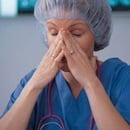
A Familiar Story: Delirium in the Acute Care Setting
A few years ago, I received report that a patient was ready to be weaned from the ventilator. He had no respiratory need for mechanical ventilation, and every time the medical team attempted to wean sedation to extubate, the patient “went crazy.”
As I assumed care on the night shift, I looked into the eyes of this intubated 67-year-old male patient. I asked him gently and quietly, “Why can’t you remain calm so we can pull out your breathing tube?” His eyes glazed-over and he tried to move his restrained hands. I released one restraint. He started to grab at the air like he was trying to catch something. I released the other restraint. Both hands shot to the ceiling, grabbing the air.
I looked at him and said, “You are seeing things!” Tears fell down his face. He gently closed his eyes while he slowly rested his hands back to the bed. I placed the restraints back on, and went to the resident to ask for an anti-psychotic medication.
And then I understood what was happening; my patient was experiencing delirium!
Delirium is often an acute onset, clouded state of consciousness, with diminished concentration ability, and/or hypersensitivity to sights and sounds. It affects an estimated 14–56% of all hospitalized elderly patients. At least 20% of the 12.5 million patients over 65 years of age hospitalized each year in the U.S. experience complications during hospitalization because of delirium (Fong, Tulebaev, & Inouye, 2009). Signs and symptoms include:
- Acute onset of global impairment
- Anxiety & internal tension
- Clouded consciousness
- Decreased attention span
- Distractibility
- Disorientation (to person, place, time)
- Disturbed sleep-wake cycle
- Fluctuating course
- Hallucinations
- Memory impairment
- Restlessness & irritability
- Perceptual disturbances
- Rambling incoherent speech
The Society of Critical Care Medicine (SCCM) suggests using the THINK acronym for identification of causes when delirium is present:
Toxic situations: CHF, shock, dehydration, deliriogenic meds (tight titration of sedatives), new organ failure (e.g. liver, kidney)
Hypoxemia
Infection/sepsis (nosocomial)
Immobilization
Nonpharmacologic interventions: hearing aids, glasses, sleep protocols, music, noise control, ambulation
K: K+ or electrolyte problems
There are (3) three tools available for use in non-ICU hospital settings and can be referenced from the ICU Delirium and Cognitive Impairment Study Group. Note: Refer to your hospital protocol before using any delirium assessment tools.
It is important to use delirium assessment tools specific to your area of practice to prevent, diagnose and treat delirium. Early recognition and effective treatment of delirium is essential to reduce complications and extended hospital stays.
Learn more about patient assessment with the RN.com CE course, Focused Physical Examination for the Acute Care Setting (1 contact hour).
Biography:
Shelley Lynch has been publishing with RN.com since 2003 and has more than 14 years of critical care nursing experience. She has worked in a variety of intensive care units in some of the nation’s top hospitals and is a nursing consultant to law firms and medical device companies. Shelley is also an AHA instructor and teaches, both ACLS and BLS classes in the Boston area. In addition, she is a bedside ICU nurse in Boston.
References:
Fong, T.G., Tulebaev, S.R., & Inouye, S.K. (2009). Delirium in elderly adults: Diagnosis, prevention and treatment. Nature Reviews Neurology, 5(4): 210-220. ICU Delirium and Cognitive Impairment Study Group. (2014). Monitoring delirium in the ICU. Retrieved from http://www.icudelirium.org/delirium.html




